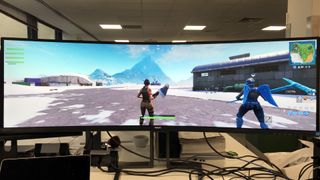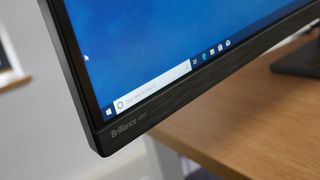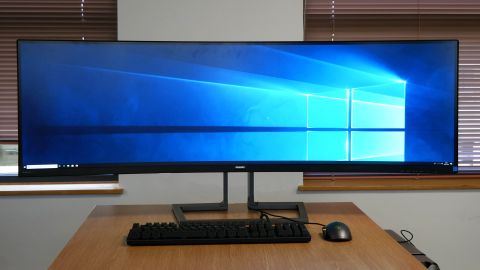TechRadar Verdict
Philip’s new insanely wide 32:9-aspect 49-inch monitor is packed with practical features, proving that it's much more than just a pretty face
Pros
- +
Interesting alternative to dual monitors
- +
Great feature set
- +
Good LCD panel quality
Cons
- -
Too big for some desk spaces
- -
Mediocre pixel pitch
- -
Very expensive
Why you can trust TechRadar
It takes a lot to turn heads at TechRadar Towers. When it comes to technology, frankly, we’ve seen it all before. But the new Philips Brilliance 499P9H ultrawide monitor pretty much brings the office to a standstill. It’s that dramatic.
Question is, are the goggling onlookers impressed, amused or even horrified by the 499P9H’s 49 inches of insanely wide-aspect LCD panel? Answer: There was plenty of laughing but also some serious consideration of this exceptional PC monitor as a practical proposition.
Of course, this Philips beast isn’t the first monitor we’ve seen with an extreme 32:9 aspect ratio. For instance, we had a sniff around Samsung’s C49J89 last summer. But Philips moves the game on by addressing that Samsung unit’s most obvious failing, namely its relatively low 1,080-pixel vertical resolution. The 499P9H ups that to 1,440 vertical pixels along with 5,120 in the horizontal plane.
It remains a pretty extreme example of the monitor maker’s art, of course, both in terms of its proportions and its price. The challenge, therefore, is to justify the hefty price tag courtesy of an exceptional viewing and ergonomic experience. Game on.

Price and availability
Availability of Philips’ new mega screen is currently limited, but we’d expect a US price of around $1,100, while the UK RRP is £989 (around AU$1,500).
The very first retail examples are being offered for substantially higher prices, but we expect the price to settle near the officially recommended level soon. That puts it very much in the same ballpark as the similar but lower-resolution Samsung C49J89. Check out the LG 49WL95C, another 49-inch monitor.

Design and features
A screen on this epic scale needs some serious engineering. For the most part, Philips delivers. Assembling the stand is a little fiddly. But once erected the 499P9H feels stable and robust, which is no mean feat given the huge expanse of screen.
Specifically, we’re talking 49 inches in a 32:9 aspect ratio, 5,120 by 1,440 pixels and 1800r screen curvature. It’s pretty hard to process the meaning of those crazy numbers. But one way to visualise it is as two 27-inch 2,560 by 1,440 LCD panels sitting side by side. That monster panel apart, this screen has some significant additional extras.
For starters, you get adaptive sync for smoother in-game performance (more on that momentarily). Next up is a USB Type-C interface. Not only does it allow you to drive the panel itself. It also enables docking functionality including an RJ-45 ethernet port.
Not enough? There’s an integrated KVM switch, too, allowing you to hook up two PCs while running a single keyboard and mouse. Another neat feature is the pop-up webcam with Windows Hello support for snappy face-ID login, even if the implementation in this case feels a little bit shonky when you pop the camera in and out. It’s the one area of build quality that doesn’t inspire confidence.

Rounding out the core feature set is DisplayHDR 400 certification. As we’ve discussed on TechRadar, this is the very bottom rung of HDR capability.
It doesn’t require local dimming and as the name implies only dictates a maximum brightness of 400cd/m2. It doesn’t have the makings of a true HDR experience. Think of it more as the ability to process an HDR signal and add a little extra visual pop.

Performance
The sheer scale of the Philips Brilliance 499P9H is a serious distraction. But if you can get past bonkers-wide format, what is it actually like for LCD panel quality?
For starters, it’s a VA rather than IPS panel, which comes with pros and cons. On the upside, colors are vibrant and there’s plenty of contrast, the latter indicated by a very strong 3,000:1 static rating.
Consequently, the Phillips 499P9H makes the most of its DisplayHDR 400 support. It’s not the full HDR experience, then. But it’s still a very punchy panel.
Likewise, there’s little evidence of compression in both black and white scales. In other words, the 499P9H offers plenty of detail in both bright and dark images. It also suffers from little to no input pag and the pixel response is decent. By those metrics, it makes for an intriguing gaming proposition.

Less impressive are the viewing angles. That’s perhaps not a huge surprise, given the VA panel type. But on a screen of this scale, one where the user is inevitably viewing parts of the panel from quite extreme angles even with the 1800r curvature, it’s a bit of a niggle.
Assessing the rest of the experience is a function of the size, aspect ratio and resolution of that massive panel. With 5,120 by 1,400 pixels across 49 inches, the DPI works out at a fairly mundane 108.5 pixels per inch. The benefit of that is the ability to run Windows at 100 per cent scaling while maintaining legibility. But this is not a high density display capable of rendering ultra smooth fonts.
As for the insane 32:9 aspect ratio, that’s a subjective call. For sure it means mousing all the way across the desktop is a choice between taking multiple swipes at it and setting the sensitivity towards the frenetic end of the spectrum. It also hardly makes for the best multimedia solution.
Even full cinema format 21:9 video content only fills part of the screen, leaving large black bars on either side of the image. For games, the result is undeniably visually spectacular. But it doesn't necessarily give you a wider view of the game world.
Competitive online titles such as Fortnite simply stretch the image progressively as you move away from the centre of the field of view in order that players using such ultrawide panels don’t enjoy an advantage.
Oh and for the record, that 5,120 by 1,440 pixel grid actually makes for slightly fewer pixels than 4K, but still represents a serious load on your graphics subsystem. You’ll need one heck of a graphics card to game smoothly.

Verdict
Ultimately, the appeal of a screen like the new Philips Brilliance 499P9H is a personal call. It’s undeniably spectacular and makes for an intriguing alternative to a pair of smaller panels. With the inbuilt KVM switch and multi-purpose UBS-C dock, it could make for a neater solution too.
On the other hand, at this price point you could have a pair of decent 32-inch 4K panels for slightly less money or a brace of high quality 27-inch IPS 4K monitors for a similar investment. In productivity terms, both of those options would probably be more rewarding and certainly offer far more pixels to work with.
What they lack is the visual drama and the feel good factor of such a huge screen, not to mention the relative ergonomic advantages of hooking up a single display.
In the end, these 32:9 monitors are likely to remain niche models rather than eventually transition to the mainstream. But for those who particularly enjoy the ultra-wide aspect and appreciate the usability and extra features on offer, the Philips Brilliance 499P9H could be hard to resist.
Images credits: TechRadar
Technology and cars. Increasingly the twain shall meet. Which is handy, because Jeremy (Twitter) is addicted to both. Long-time tech journalist, former editor of iCar magazine and incumbent car guru for T3 magazine, Jeremy reckons in-car technology is about to go thermonuclear. No, not exploding cars. That would be silly. And dangerous. But rather an explosive period of unprecedented innovation. Enjoy the ride.

